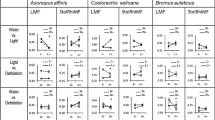Abstract
We tested the hypothesis that herbaceous climbing plants, unlike non-climbing herbs, maximize height growth and leaf area, with minimal expenditure in support structures. The enhanced investment in leaf area was expected to result in high relative growth rates in terms of biomass increment.
Four leguminous herbaceous climbers from nutrient-poor sites and four non-leguminous herbaceous climbers from nutrient-rich sites, were compared with non-climbing, self-supporting leguminous and non-leguminous herbaceous species from similar habitats. Plants were grown in hydroponic cultures in controlled environment chambers.
All climbers had inherently taller shoots than self-supporting plants when compared at an equal amount of total plant dry weight, due to longer stems per unit of support biomass. In contrast to the hypothesis, the relative growth rates of all climbers were relatively low compared to the range found for self-supporting species. The biomass allocation patterns of the non-leguminous climbers were similar to those of the self-supporting species. Leguminous climbers allocated more biomass to support tissue and less biomass to leaves than non-climbers. As a result, height growth was even more emphasized in leguminous climbers than in non-leguminous climbers. Climbing legumes had high rates of net carbon gain, which partly compensated the lower relative leaf weight.
We conclude that leguminous herbaceous climbers maximize height growth by a large investment in support biomass, enabling them to keep a large proportion of their leaves in the better illuminated environment at the top of the vegetation canopy.
Similar content being viewed by others
References
Bell D J, Forseth I N and Teramura A H 1988 Field water relations of three temperate vines. Oecologia 74, 537–545.
Castellanos V, Durán R, Guzmán S, Briones O and Feria M 1992 Three-dimensional space utilization of lianas: a methodology. Biotropica 24, 396–401.
Croat T B 1988 Ecology and life forms of Araceae. Aroideana 11, 4–55.
Cutler H C 1939 Monograph of the North American species of Ephedra. Ann. Miss. Bot. Garden 26, 373–424.
Darwin C 1867 The movements and habits of climbing plants. J. Linn. Soc., Bot. 9, 1–118.
DenDubbelden K C and Oosterbeek B 1995 The availability of external support affects allocation patterns and morphology of herbaceous climbing plants. Func. Ecol. 9, 628–634.
During H J, Kwant R and Werger M J A 1994 Effects of light quantity on above-ground biomass investment patterns in the vine Lonicera periclymenum and the shrub Lonicera xylosteum. Phytocoenologia 24, 597–607.
Evans G C 1972 The Quantitative Analysis of Plant Growth. Blackwell Scientific Publications, Oxford, UK.
Frey D and Frick H 1987 Altered partitioning of dry matter in Hedera helix L. (Araliaceae) induced by altered orientation. Bull. Torrey Bot. Club 114, 407–411.
Garnier E 1992 Growth analysis of congeneric annual and perennial grass species. J. Ecol 80, 665–675.
Gartner B L 1991 Relative growth rates of vines and shrubs of western poison oak, Toxicodendron diversilobum (Anacardiaceae). Am. J. Bot. 78, 1345–1353.
Gentry A 1991 The distribution and evolution of climbing plants. In The Biology of Vines. Eds. F EPutz and H AMooney. pp 3–42. Cambridge University Press, Cambridge, UK.
Grime J P and Hunt R 1975 Relative growth-rate: its range and adaptive significance in a local flora. J. Ecol. 63, 393–422.
Hegarty E E 1989 The climbers-lianes and vines. In Tropical Rain Forest Ecosystems: Biogeographical and Ecological Studies-Ecosystems of the World 14B Eds. HLieth and M J AWerger. pp 339–353. Elsevier, Amsterdam, the Netherlands.
Niklas K J 1994 Comparisons among biomass allocation and spatial distribution patterns of some vine, pteridophyte, and gymnosperm shoots. Am. J. Bot. 81, 1416–1421.
Page C N 1979 The diversity of ferns: an ecological perspective. In Experimental Biology of Ferns. Ed. A FDryer. pp 9–56. Academic Press, London, UK.
Peñalosa J 1983 Shoot dynamics and adaptive morphology of Ipomoea phillomega (Vell.) house (Convolvulaceae), a tropical rainforest liana. Ann. Bot. 52, 737–754.
Poorter H 1989 Plant growth analysis: towards a synthesis of the classical and the functional approach. Physiol. Plant. 75, 237–244.
Poorter H and Remkes C 1990 Leaf area ratio and net assimilation rate of 24 wild species differing in relative growth rate. Oecologia 83, 553–559.
Putz F E 1983 Liana biomass and leaf area of a ‘Tierra firme’ forest in the Rio Negro Basin, Venezuela. Biotropica 15, 185–189.
Putz F E 1984 The natural history of lianas on Barro Colorado Island, Panama. Ecology 65, 1713–1724.
Ray T S 1992 Foraging behaviour in tropical herbaceous climbers (Araceae). J. Ecol. 80, 189–203.
SAS Institute Inc. 1988 SAS/STAT User's Guide, Release 6.03 Edition. SAS Institute Inc., Cary, NC, USA.
Teramura A H, Gold W G and Forseth I N 1991 Physiological ecology of mesic, temperate woody vines. In Biology of Vines. Eds. F EPutz and H AMooney. pp 245–285. Cambridge University Press, Cambridge, UK.
Van derMeijden R, Weeda E J, Holverda W J and Hovenkamp P H 1990 Flora van Nederland. Wolters-Noordhoff, Groningen, the Netherlands.
Vessey J K and Waterer J 1992: In search of the mechanism of nitrate inhibition of nitrogenase activity in legume nodules: recent developments. Physiol. Plant. 84, 171–176.
Whigham D F 1984 The effect of competition and nutrient availability on the growth and reproduction of Ipomoea hederacea in an abandoned old field. J. Ecol. 72, 721–730.
Author information
Authors and Affiliations
Rights and permissions
About this article
Cite this article
den Dubbelden, K.C., Verburg, R.W. Inherent allocation patterns and potential growth rates of herbaceous climbing plants. Plant Soil 184, 341–347 (1996). https://doi.org/10.1007/BF00010463
Received:
Accepted:
Issue Date:
DOI: https://doi.org/10.1007/BF00010463




